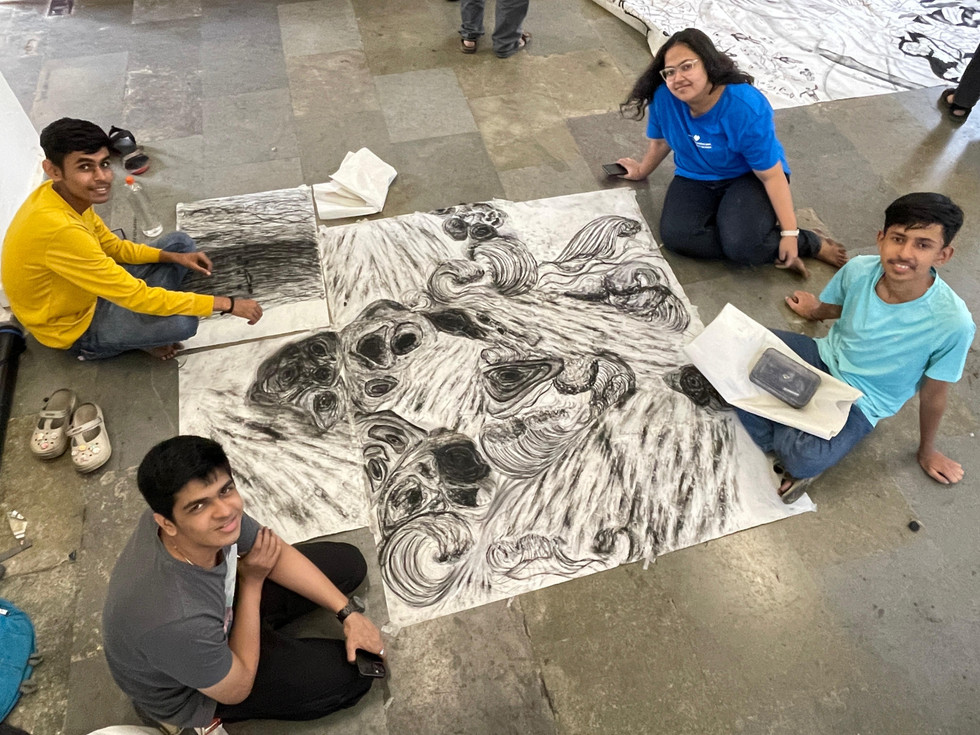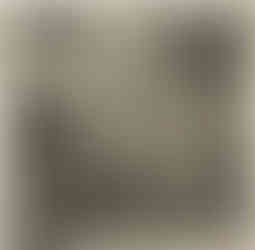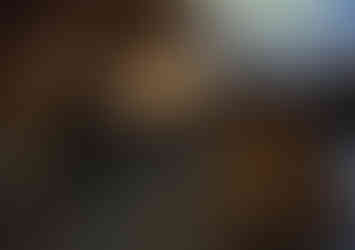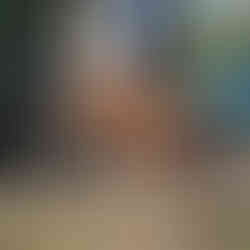Orientation Module: Slumberland
- Juhi Iyengar
- Sep 25, 2024
- 5 min read
Studio Co-ordinator: Kausik Mukhopadhyay
Juhi Iyengar
The Orientation module introduced a deep, process driven exploration of spatial thinking, collaboration, and emotional storytelling through form and material. It began with each student creating individual drawings based on personal dreams or subconscious imagery. This exercise evoked emotional sensitivity and creativity within us. Our sketches were not simply viewed; we learned to read, interpret, and analyze them to uncover emotions and underlying themes. Once we moved past the stage of making individual drawings, we were grouped and challenged to combine our collective ideas into large-scale group drawings. This phase involved extensive discussion, brainstorming, and merging different perspectives, requiring a lot of collaboration and compromise. The group drawings became tools for shaping multiple abstract ideas into a collective visual story.
As the drawings evolved, so did our understanding of space. As groups, we explored density, depth, movement, distortion, and layering in our drawings, developing them over several iterations. These two-dimensional explorations then became the foundation for installations, where the real challenge emerged — translating emotional and compositional density into spatial, sensory experiences.
The transition from drawing to installation wasn’t straightforward. We went through cycles of trial and error, experimenting with different materials, reconsidering forms and continuously iterating. We were unfamiliar with most materials like bamboo, corrugated sheets, wire, or nets. All materials were chosen through active testing, negotiation, and adaptability, selected equally for their physical properties and their alignment with the concepts.
Throughout this process, teamwork was key. We navigated creative differences, learned from each other’s failures and successes, and discovered how to listen, critique, and contribute collectively. The process blurred the distinction between individual and group work, emphasizing collaboration as a deliberate creative approach. In addition to that, we began to think about space in a very new way, not just the physical dimensions but as an experiential and sensory medium. We worked with large scales, expanded into corners and heights, and learned to think in terms of volume, direction, flow, and density. The final installations were more than structures. They were immersive experiences, capturing intense sensations such as tension, motion, disorientation, or submersion.
Ultimately, the module was not about arriving at a perfect product but about learning through doing. Through failure, improvisation, iteration, and exploration of the connection between emotion, space, form, and material.

A Floating World
Our group explored the idea of density and crowding, focusing on how people move through objects and compact spaces. We had drawings that reflected on the interaction between motion and obstruction, using repeated marks and overlapping forms to visualize complexity. All of us produced sketches that were eventually merged into a single large composition.
As the concept got translated into an installation, it took the form of a cantilever frame made from scrap materials with discarded everyday objects suspended from it. These objects were arranged to create a dense, chaotic environment, forming pathways through the cluttered space, resulting in a maze of objects and shadows. Through the process, we learned practical skills like bargaining (with bhangar-walas), gained an understanding of how space can be both experienced and constructed and how discarded objects could take on new life when thoughtfully placed in dialogue with one another.
Stairs
Our individual dream-based drawings centered on the emotion of fear. We took forward elements from those drawings that depicted transitions between spaces like stairs, ladders, blocks, and pathways, and began constructing a large collective drawing. From this emerged the concept of a labyrinth, with the staircase as its core, as a form that suggests both an escape and entrapment. Thus the group drawing became a study of tension and uncertainty, reflecting the experience of navigating fear.
Translating this into a spatial installation, we kept stairs as the core element and imagined an interwoven space. The process required constant reimagination as we sought to maintain the abstract quality of the drawing. We selected file-card for its stability, and experimented with different scales, directions and types of stairs that led to tunnels, folding and dissolving into other stairways. We imagined movement along these stairs as a way to evoke feelings of fear, uncertainty and disorientation of a labyrinth. The final installation created an immersive, disorienting experience of a space that made the viewer encounter the feeling of unease.
Arches
Our group explored the feeling of being lost, a sensation of confusion and spatial disorientation. The drawing process was highly iterative, as we manipulated arch sizes, crowd densities, and directional flows to create visual depth. Each revision added new layers, transforming our work into a meditation on rhythm and density.
The drawing became the foundation for the installation. We selected G14 galvanized wire and winding wire for their structural flexibility and expressive potential. Working with wire required patience and problem-solving; each bend and connection had to be carefully controlled to preserve the sense of openness and complexity as in the drawings. The resulting structure formed an intricate network of intersecting coils that invited viewers to move through constrained, overlapping spaces, evoking the unsettling yet compelling experience of being lost within form and movement.
Waves
Our group's work primarily focused on distortion, force, and submersion. We began by merging our individual drawings, which were inspired by our dreams, to create two major pieces. One centered around force: portrayed through the powerful nature and forcefulness of the waves; and the other around distortion and fragmentation: displayed through the variety of elements put forth from our dreams. The process of creating these drawings required collaborative effort to compose pieces that conveyed motion and turbulence through layered strokes and tonal shifts.
For our installation, we translated this visual motion and flow into physical space using fabric nets and a metallic wire framework. The materials were chosen for their flexibility and transparency, allowing forms of flowing, suspended wave patterns to express overwhelm. We established a structure that simulated the feeling of being underwater — light, shadow, and texture working together. Their project became an exploration of how space and material can replicate sensory experience.
Deconstructed Studio
The group members' individual sketches explored themes of distortion, loneliness, and flow. Our process began with large-scale group drawings created from fragments of individual dream sketches. We physically cut, rearranged, and merged sketches to form abstract compositions that captured energy and emotion, and layered gestural strokes to emphasize dynamism, speed, and distortion.
When transitioning to the installation, after multiple experiments with fabric, plaster and paper, we chose corrugated sheets, a material that balanced rigidity and fluidity. Through cutting, folding, and stitching, the sheets were shaped into smooth, curving forms that extended from a corner of the studio and spread outward spontaneously, like the unpredictable nature of our drawing, creating an immersive and continuous spatial flow. The installation retained the energy of the drawing, while its form embodied the process of deconstruction and reassembly, communicating the group’s conceptual approach. Our process reflected how structure can emerge organically through improvisation and material dialogue.
Creatures
Our group took a different route, channeling our exploration into the surreal and fantastical. We started with dreams — opening endless possibilities for each member to make quick, intuitive sketches of imagined beings that blended absurdity and curiosity. Through discussions about the spaces these creatures might inhabit, we merged our ideas into a cohesive vision, influenced by artists like Bosch and Piranesi. The resulting group drawing depicted a surreal landscape populated by bizarre beings of our own making.
For the installation, we constructed sculptural “creatures” using bamboo as a structural framework and file cards for surface texture. The process involved experimenting with tessellation and folding techniques, allowing the group to generate complex surfaces from simple modular forms. This hands-on approach to form making allowed us to discover how to balance strength, flexibility, and structure. The final installation was an ensemble of expressive, semi-abstract creatures inhabiting a shared space. It offered a playful and thought-provoking exploration of how imagination, materials, and teamwork can combine to create the surreal within the real.





























































Comments